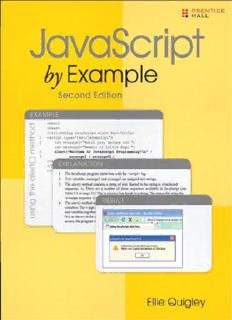
JavaScript by Example, Second Edition PDF
Preview JavaScript by Example, Second Edition
JavaScript by Example Second Edition ELLIE QUIGLEY Upper Saddle River, NJ • Boston • Indianapolis • San Francisco New York • Toronto • Montreal • London • Munich • Paris • Madrid Capetown • Sydney • Tokyo • Singapore • Mexico City Many of the designations used by manufacturers and sellers to distinguish their products are claimed as trademarks. Where those designations appear in this book, and the publisher was aware of a trademark claim, the designations have been printed with initial capital letters or in all capitals. The author and publisher have taken care in the preparation of this book, but make no expressed or implied warranty of any kind and assume no responsibility for errors or omissions. No liability is assumed for incidental or consequential damages in connection with or arising out of the use of the information or programs contained herein. The publisher offers excellent discounts on this book when ordered in quantity for bulk purchases or special sales, which may include electronic versions and/or custom covers and content particular to your business, training goals, marketing focus, and branding interests. For more information, please contact: U.S. Corporate and Government Sales (800) 382-3419 [email protected] For sales outside the United States, please contact: International Sales [email protected] Visit us on the Web: informit.com/ph Editor-in-Chief Mark L. Taub Managing Editor John Fuller Full-Service Production Manager Julie B. Nahil Production Editor Dmitri Korzh Techne Group Copy Editor Teresa Horton Indexer Potomac Indexing, LLC Proofreader Beth Roberts Editorial Assistant Kim Boedigheimer Cover Designer Anne Jones Composition Techne Group Library of Congress Cataloging-in-Publication Data Quigley, Ellie. JavaScript by example / Ellie Quigley.—2nd ed. p. cm. Includes index. ISBN 978-0-13-705489-3 (pbk. : alk. paper) 1. JavaScript (Computer program language) I. Title. QA76.73.J39Q54 2010 005.13’3—dc22 2010020402 Copyright © 2011 Pearson Education, Inc. All rights reserved. Printed in the United States of America. This publication is protected by copyright, and permission must be obtained from the publisher prior to any prohibited reproduction, storage in a retrieval system, or transmission in any form or by any means, electronic, mechanical, photocopying, recording, or likewise. For information regarding permissions, write to: Pearson Education, Inc. Rights and Contracts Department 501 Boylston Street, Suite 900 Boston, MA 02116 Fax: (617) 671-3447 ISBN-13: 978-0-13-705489-3 ISBN-10: 0-13-705489-0 Text printed in the United States on recycled paper at Edwards Brothers in Ann Arbor, Michigan. First printing, October 2010 Contents Preface 1 Introduction to JavaScript 1.1 What JavaScript Is 1.2 What JavaScript Is Not 1.3 What JavaScript Is Used For 1.4 JavaScript and Its Place in a Web Page 1.4.1 Analysis of the Diagram 1.5 What Is Ajax? 1.6 What JavaScript Looks Like 1.7 JavaScript and Its Role in Web Development 1.7.1 The Three Layers 1.8 JavaScript and Events 1.9 Standardizing JavaScript and the W3C 1.9.1 JavaScript Objects 1.9.2 The Document Object Model 1.10 What Browser? 1.10.1 Versions of JavaScript 1.10.2 Does Your Browser Follow the Standard? 1.10.3 Is JavaScript Enabled on Your Browser? 1.11 Where to Put JavaScript 1.11.1 JavaScript from External Files 1.12 Validating Your Markup 1.12.1 The W3C Validation Tool 1.12.2 The Validome Validation Tool 1.13 What You Should Know 2 Script Setup 2.1 The HTML Document and JavaScript 2.1.1 Script Execution 2.2 Syntactical Details 2.2.1 Case Sensitivity 2.2.2 Free Form and Reserved Words 2.2.3 Statements and Semicolons 2.2.4 Comments 2.2.5 The <script> Tag 2.3 Generating HTML and Printing Output 2.3.1 Strings and String Concatenation 2.3.2 The write() and writeln() Methods 2.4 About Debugging 2.4.1 Types of Errors 2.5 Debugging Tools 2.5.1 Firefox 2.5.2 Debugging in Internet Explorer 8 2.5.3 The JavaScript: URL Protocol 2.6 JavaScript and Old or Disabled Browsers 2.6.1 Hiding JavaScript from Old Browsers 2.7 What You Should Know 3 The Building Blocks: Data Types, Literals, and Variables 3.1 Data Types 3.1.1 Primitive Data Types 3.1.2 Composite Data Types 3.2 Variables 3.2.1 Valid Names 3.2.2 Declaring and Initializing Variables 3.2.3 Dynamically or Loosely Typed Language 3.2.4 Scope of Variables 3.2.5 Concatenation and Variables 3.3 Constants 3.4 Bugs to Watch For 3.5 What You Should Know 4 Dialog Boxes 4.1 Interacting with the User 4.1.1 The alert() Method 4.1.2 The prompt() Method 4.1.3 The confirm() Method 4.2 What You Should Know 5 Operators 5.1 About JavaScript Operators and Expressions 5.1.1 Assignment 5.1.2 Precedence and Associativity 5.2 Types of Operators 5.2.1 Arithmetic Operators 5.2.2 Shortcut Assignment Operators 5.2.3 Autoincrement and Autodecrement Operators 5.2.4 Concatenation Operator 5.2.5 Comparison Operators 5.2.6 Logical Operators 5.2.7 The Conditional Operator 5.2.8 Bitwise Operators 5.3 Number, String, or Boolean? Data Type Conversion 5.3.1 The parseInt() Function 5.3.2 The parseFloat() Function 5.3.3 The eval() Function 5.4 Special Operators 5.5 What You Should Know 6 Under Certain Conditions 6.1 Control Structures, Blocks, and Compound Statements 6.2 Conditionals 6.2.1 if/else 6.2.2 if/else if 6.2.3 switch 6.3 Loops 6.3.1 The while Loop 6.3.2 The do/while Loop 6.3.3 The for Loop 6.3.4 The for/in Loop 6.3.5 Loop Control with break and continue 6.3.6 Nested Loops and Labels 6.4 What You Should Know 7 Functions 7.1 What Is a Function? 7.1.1 Function Declaration and Invocation 7.1.2 Return Values 7.1.3 Anonymous Functions as Variables 7.1.4 Closures 7.1.5 Recursion 7.1.6 Functions Are Objects 7.2 Debugging Techniques 7.2.1 Function Syntax 7.2.2 Exception Handling with try/catch and throw 7.3 What You Should Know 8 Objects 8.1 What Are Objects? 8.1.1 Objects and the Dot Syntax
Description: